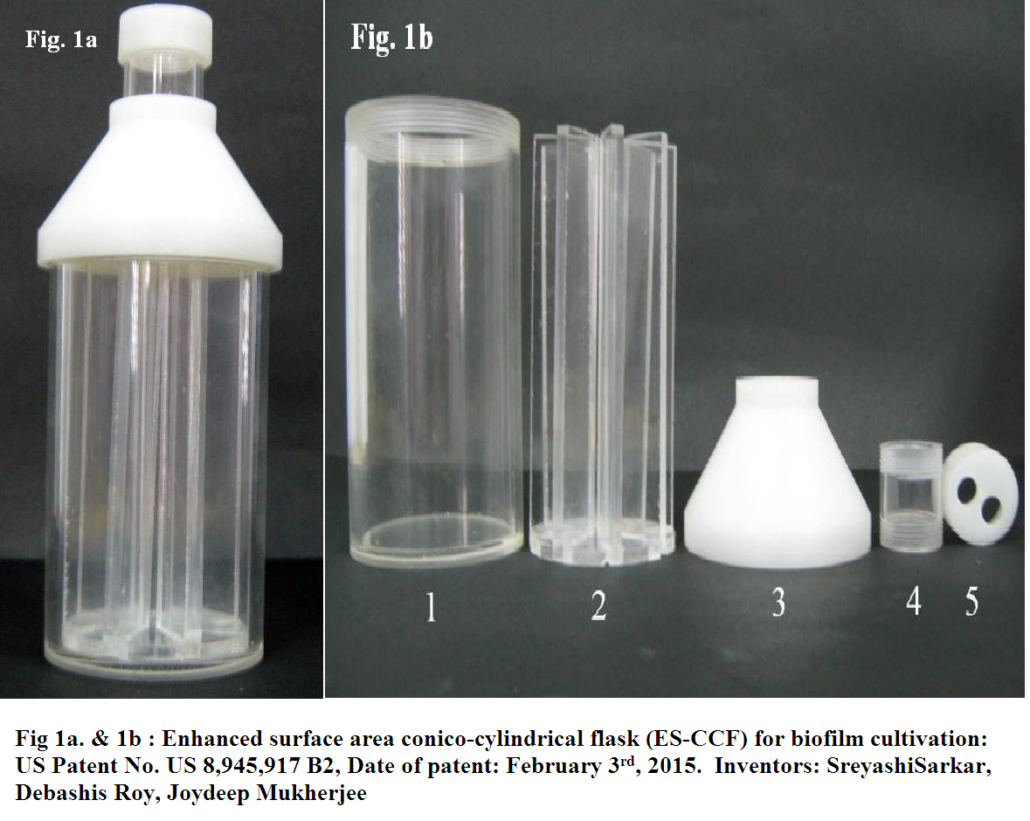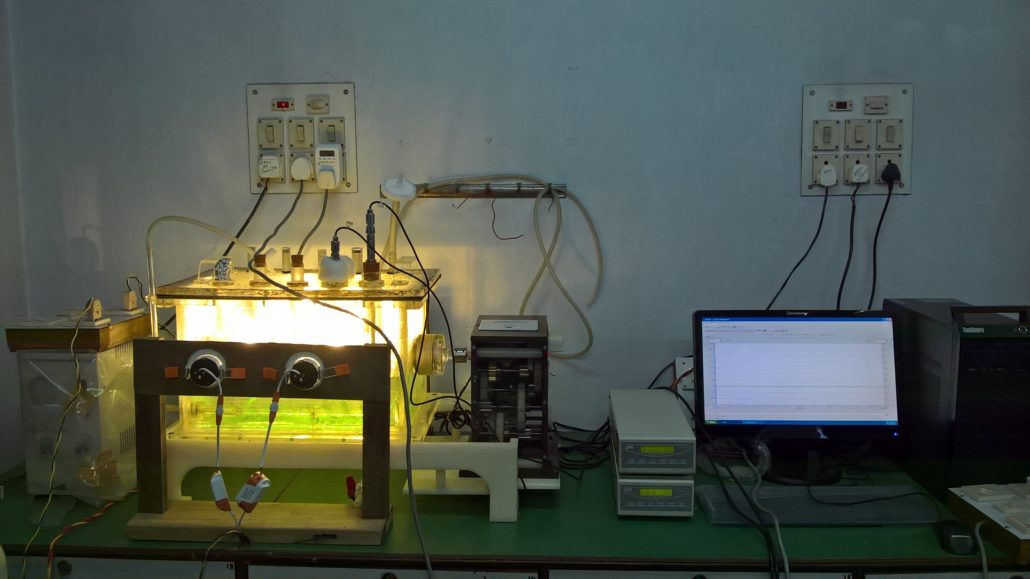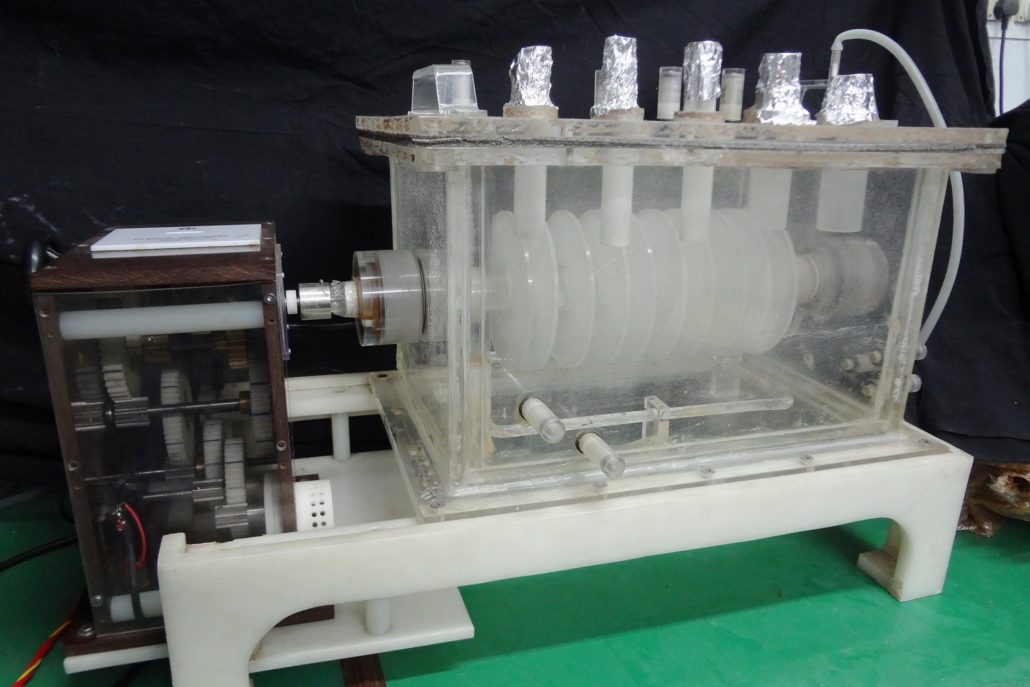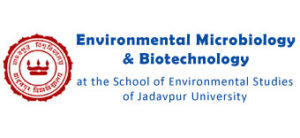

After initial small-scale experiments, a 25.0 l rotating disk bioreactor (RDBR) was investigated for the cultivation of a biofilm-forming salt-tolerant Streptomyces sundarbansensis producing an antimicrobial compound. Peak activity attainment rate, PAAR (ratio of the peak antimicrobial activity, PAMA and the time taken to attain PAMA) was determined. Of the three pH values examined (8.0, 9.0 and 10.0) maximum PAAR (1.82 mm/h) was attained at pH 9.0. Three aeration rates (9.0, 6.0 and 3.0 l/min) were considered at three levels (25, 50 and 75%) of disk submergence. At the highest aeration rate and 50% submergence level, PAMA (41 mm), PAAR (1.86 mm/h) and biofilm density (BD, 0.91 g/ml) attained their highest values. At any given aeration rate, PAMA was always higher at 50% submergence level. This supports our earlier premise (see above) that ideal intertidal conditions, 12 h periods of immersion and emersion, promote maximum BD and antimicrobial production in the niche-mimic RDBR.
Actinomycin-D production by a biofilm-forming estuarine isolate, viz. Streptomyces sp. MS 310 was studied in small scale shaken cultures, as well as in a 25 L rotating disk bioreactor, (RDBR) which, when operated at a disk rotational speed of 1 revolution/day with 50% disk submergence, mimicked the intertidal conditions of the microbe’s niche estuarine habitat- alternating 12 h periods of inundation and exposure. The ideal pH and temperature for antibiotic production were determined (pH 10, 30 ºC) through a designed experimental study using shaken flasks. Subsequently, operating conditions in the RDBR were investigated employing a 3n experimental design wherein each of two (n = 2) parameters viz. aeration and disk submergence were considered at three levels viz. high, medium, and low: 9.0, 6.0, and 3.0 l/min for aeration rate; and 75, 50, and 25% for disk submergence, (while maintaining the rotational speed at 1.0 rev/day). The niche-mimic condition along with maximum permissible aeration was found to be most favorable for antibiotic production – peak antibiotic activity (PAA) and peak activity attainment rate (PAAR) simultaneously attained their highest values: 40 mm and 2.13 mm/h, respectively. Both PAA and PAAR increased with increasing aeration at all operating conditions examined – particularly, at the niche-mimic condition, a threefold increase in aeration rate (3~9 L/min) caused PAA to increase by 33%, whereas PAAR increased by 2.5 times, thus pointing to the strong aeration dependence of this actinomycin-D producer. Again, compared to the best values obtained in the 500 ml shaken flask experiments, corresponding RDBR values were 16% higher for PAA and more than 5 times higher for PAAR – strong evidence for employing these novel bioreactors for cultivation of antibiotic-producer marine microbes.

A polymethylmethacrylate (PMMA) conico-cylindrical flask (CCF) with an inner arrangement consisting of eight equidistantly spaced rectangular strips mounted radially on a circular disk to provide additional surface area for microbial attachment was employed for protease production by the biofilm-forming bacteria, an intertidal gamma-Proteobacterium (DGII), previously isolated from the Sundarbans. The flask design allowed comparison of protease production during cultivation with a hydrophilic (glass) or hydrophobic (PMMA) surface. Compared to the Erlenmeyer flask, the CCF allowed protease production that was 30% higher and growth that was 20% higher. Protease production increased by 202% and growth by 19,275% in the presence of a hydrophobic as compared to a hydrophilic surface. This investigation pioneers the application of a vessel beyond the traditional shake-flask for enhancing protease production by biofilm-formers. This design was further applied for the cultivation of Shewanella colwelliana, a bacterium autochthonous to estuarine oyster water of Lewes, Delaware, USA, producing melanin and Pseudoalteromoans rubra, originally known as isolated from the Mediterranean waters off Nice, France, producing an antibiotic. Melanin production in the PMMA surface CCF was higher by at most 33.5% and growth of S. colwelliana by at most 309.2% compared to the glass surface CCF and the Erlenmeyer flask. Melanin synthesis was positively correlated with reactor surface area and hydrophobicity, suspended cell growth, and biofilm formation. Antibiotic production in the Erlenmeyer flask was higher by at most 83.3%, but growth of P. rubra was higher in the PMMA surface CCF by at most 54.5% compared to the other vessels. Furthermore, this design also applied for the cultivation of Chaetomium crispatum isolated from the estuarine sediments of the river Weser, Germany and Gliocladium viride, isolated from Santos estuary, Sao Paulo, Brazil. Cellulase production by C. crispatum and xylanase production by G. viride were studied. Compared with the Erlenmeyer flask, endo-beta-1,4-glucanase and FPase (filter paper degradation) activities increased from 0.044 to 0.156 and from 0.008 to 0.021 IU/ml, respectively, in the PMMA surface CCF, while growth of C. crispatum was higher by at most 1.38-fold compared with the other vessels. Xylanase production in the EF was at most 5.08-fold higher and growth of G. viride was at most 1.52-fold higher compared with the other vessels. Temporal pattern of biofilm development based on two-channel fluorescence detection of extracellular polymeric substances (EPSs) and whole cells in a confocal laser scanning microscope demonstrated increase by 100% in biovolume, 25% in thickness and 62.5% both in substratum coverage and total spreading of C. crispatum biofilm in PMMA-CCF over 6 days. Biovolume of G. viride biofilm in GS-CCF increased by 150% over 4 days while that in PMMA-CCF enhanced by 200% over 2 days. Biofilm thickness in PMMA-CCF was 44% higher compared with GS-CCF and increased by 175% over 2 days. Substratum coverage was 38% higher in GS-CCF compared with PMMA-CCF.
Riboflavin production (mg/l) increased from 12.79 to 289.96, from 54.44 to 238.14 and from 36.98 to 158.71 in the GS-CCF, EF and PMMA-CCF respectively when C. famata was grown as biofilm-induced cultures in contrast to traditional planktonic culture. Production was correlated with biofilm formation and planktonic growth was suppressed in cultivations that allowed higher biofilm formation. Enhanced aeration increased riboflavin production in hydrophilic vessels. Temporal pattern of biofilm progression based on two-channel fluorescence detection of extracellular polymeric substances and whole cells in a confocal laser scanning microscope followed by application of PHLIP and ImageJ volume-viewer software demonstrated early maturity of a well-developed, stable biofilm on glass in contrast to PMMA surface. A strong correlation between hydrophilic reactor surface, aeration, biofilm formation and riboflavin production was established in C. famata. Biofilm culture is a new-found means to improve riboflavin production by C. famata.
The aims of another investigation were to ascertain if surface attachment of Cunnighamella elegans and niche intertidal conditions provided in a bioreactor influenced biotransformation of fluoranthene by C. elegans. Fluoranthene biotransformation was higher by 22-folds, biofilm growth by three-folds and cytochrome P450 gene expression by 2.1-folds when C. elegans was cultivated with 2% inoculum as biofilm culture in PMMA-CCF compared to planktonic culture in EF. Biotransformation was enhanced by 7-folds with 10% inoculum. Temporal pattern of biofilm progression based on three-channel fluorescence detection by confocal laser scanning microscopy demonstrated well-developed, stable biofilm with greater co-localization of fluoranthene within extracellular polymeric substances and filaments of the biofilm grown on PMMA in contrast to glass surface. A bioreactor with discs rotating at two revolutions per day affording six-hourly emersion and immersion mimicked the niche intertidal habitat of C. elegans, supported biofilm formation and transformation of fluoranthene. The amount of transformed metabolite was 3.5-folds, biofilm growth was three-folds and cytochrome P450 gene expression was 1.9-folds higher in the process mimicking the intertidal conditions compared to a submerged process without disc rotation. In the CCF and reactor, where biofilm formation was comparatively greater, higher concentration of exopolysaccharides allowed increased mobilization of fluoranthene within the biofilm with consequential higher gene expression leading to enhanced volumetric productivity.


A direct relationship between biofilm formation and melanogenesis in Shewanella colwelliana with increased oyster recruitment is already established. Previously, S. colwelliana was grown in a newly patented biofilm-cultivation device, the conico-cylindrical flask (CCF) and offering interchangeable hydrophobic/hydrophilic surfaces. Melanization was enhanced when S. colwelliana was cultivated in a hydrophobic vessel compared with a hydrophilic vessel. In this study, melanogenesis in the CCF was positively correlated with increased architectural parameters of the biofilm (mean thickness and biovolume obtained by confocal laser scanning microscopy) and melanin gene (melA) expression observed by densitometry. Niche intertidal conditions were mimicked in a process operated in an ultra-low-speed rotating disk bioreactor, which demonstrated enhanced biofilm formation, melanogenesis, exopolysaccharide synthesis and melA gene expression compared with a process where 12-h periodic immersion and emersion was prevented. The wettability properties of the settling plane as well as intermittent wetting and drying, which influenced biofilm formation and melA expression, may affect oyster settlement in nature.

